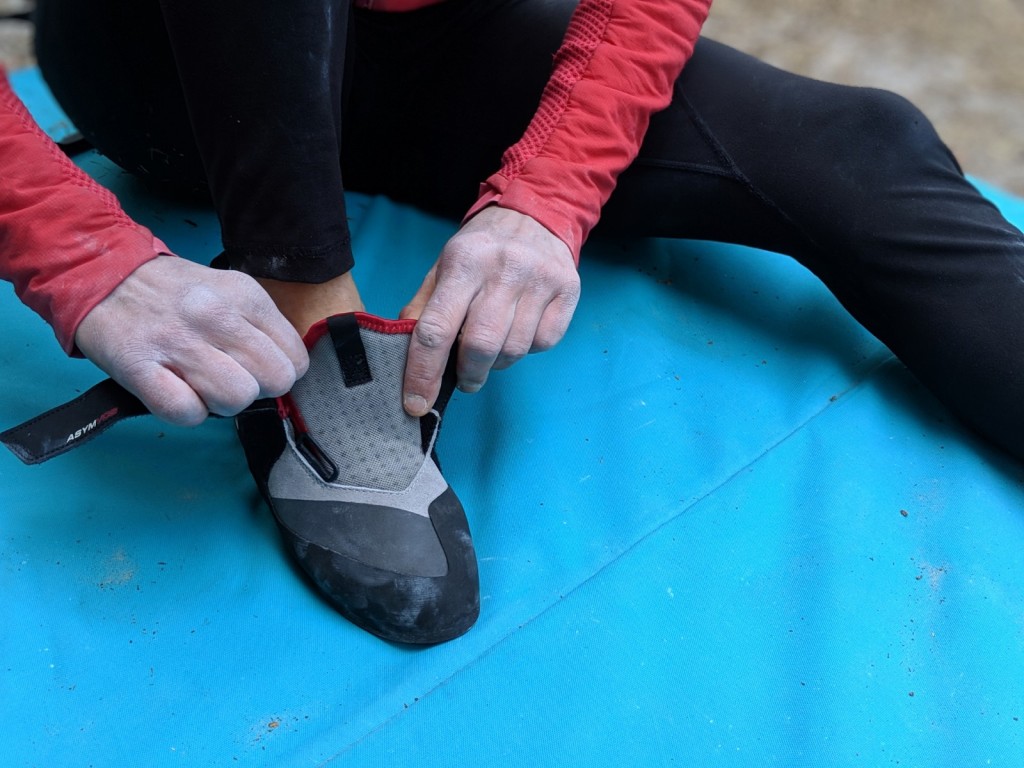Five Ten Asym - Women's Review
Our Verdict
Our Analysis and Test Results
With a problematic fit in both the heel and arch of our feet, we had a hard time climbing in the stiff Asym.
Performance Comparison
Comfort
The Five Ten Asym was a tricky one for us to break in, as they ran a little small. We had the best luck sizing up a half size. That said, the Asyms have leather uppers and will stretch out a bit with time. They're a very low volume shoe, so they fit our foot lengthwise, but our wide footed lead tester had difficulties with the width and ankle height of the shoes.
The heel was especially problematic, as the Asym has a very low-cut heel and a tight band of rubber that crosses the Achilles. We had a hard time getting our heel to set in the bottom of the heel cup properly. This meant that our heel felt like it was constantly about to pop out of the back of these shoes. We had much better luck with the Five Ten Anasazi in both the fit of the heel and the overall comfort.
Sensitivity
Though the Asym has the classic and sticky C4 Stealth rubber soles, we found the stiffness of the shoe to seriously detract from the Asym's overall sensitivity. We couldn't feel the texture of the rock beneath our toes. The stiffness and overall flat shape of the Asym also made it hard to smear or toe in hard, further detracting from the shoe's performance in our sensitivity metric.
Edging
Where the Asym's stiffness was a detraction when it came to sensitivity, it was somewhat helpful when it came to edging. These stiff, plank-like shoes were able to hold an edge, even when we didn't trust them to. The rigidity from toe to heel provides a supportive platform for the foot that extends out perpendicular from the wall, turning tiny edges into foot ledges with a little will power and faith.
The only downside was the ill-fitting heel cup, as our heel tended to lever out of the back of the shoe when standing on small edges. This was definitely problematic when trying to climb harder, more tenuous face routes.
Crack Climbing
The design of the Asym makes it a decent option for crack climbing. It looks a lot like the Five Ten Anasazi LV, which we often use as a crack climbing shoe. The fairly neutral shape and stiff soles make the Asym a good shoe for trad climbing, where cracks and face holds are both used. The Velcro buckles are also high enough on the shoe, and placed on the inside, which improves the Asym's performance in cracks; the buckle won't rub if used on routes with continuous jamming. When it comes to finger cracks, we would recommend a more flexible shoe, as it was hard to cam these stiff shoes into small splitters.
Pockets
The bulky feel and stiffness of the Asym do not make these shoes our top choice for pocketed climbing. We struggled to get the Asym into small pockets in the same way we struggled to get them into finger cracks. These shoes have a stiff toe box that lacks the flexibility needed to get into pockets, especially on steep walls.
Ease of Use
The Asym has a similar closing system to the Five Ten Anasazi LV, the La Sportiva Otaki, and the Evolv Kira. All of these shoes have two Velcro straps that cover a padded mesh tongue. This design is easier to take on and off than a lace-up style shoe. That said, we had a hard time getting our foot to feel just right, especially in the heel. These challenges dissuaded us from taking the Asyms on and off frequently, or even wearing them altogether.
Value
While the Asym may fall short in terms of performance, it makes up for in price. With a moderately low price tag of $125, the Asym is relatively affordable. The C4 Rubber is sticky, and the overall construction of the shoe seems to be made with longevity in mind. If these fit properly, they could be a good all-arounder with a reasonable price tag.
Conclusion
The Five Ten Asym did not inspire great confidence for us during our testing period, and we had a hard time trusting the smeary, slippery feet found on the boulders in Fontainebleau. We also had issues with their low-volume fit, as it didn't fit our various testers' foot shape. The low-cut ankle and tight heel cup had our heel feeling like it was about to pop out of the back of the shoe. The Asym is best suited for climbing on vertical to lower angle terrain where stiffness underfoot is an advantage.











